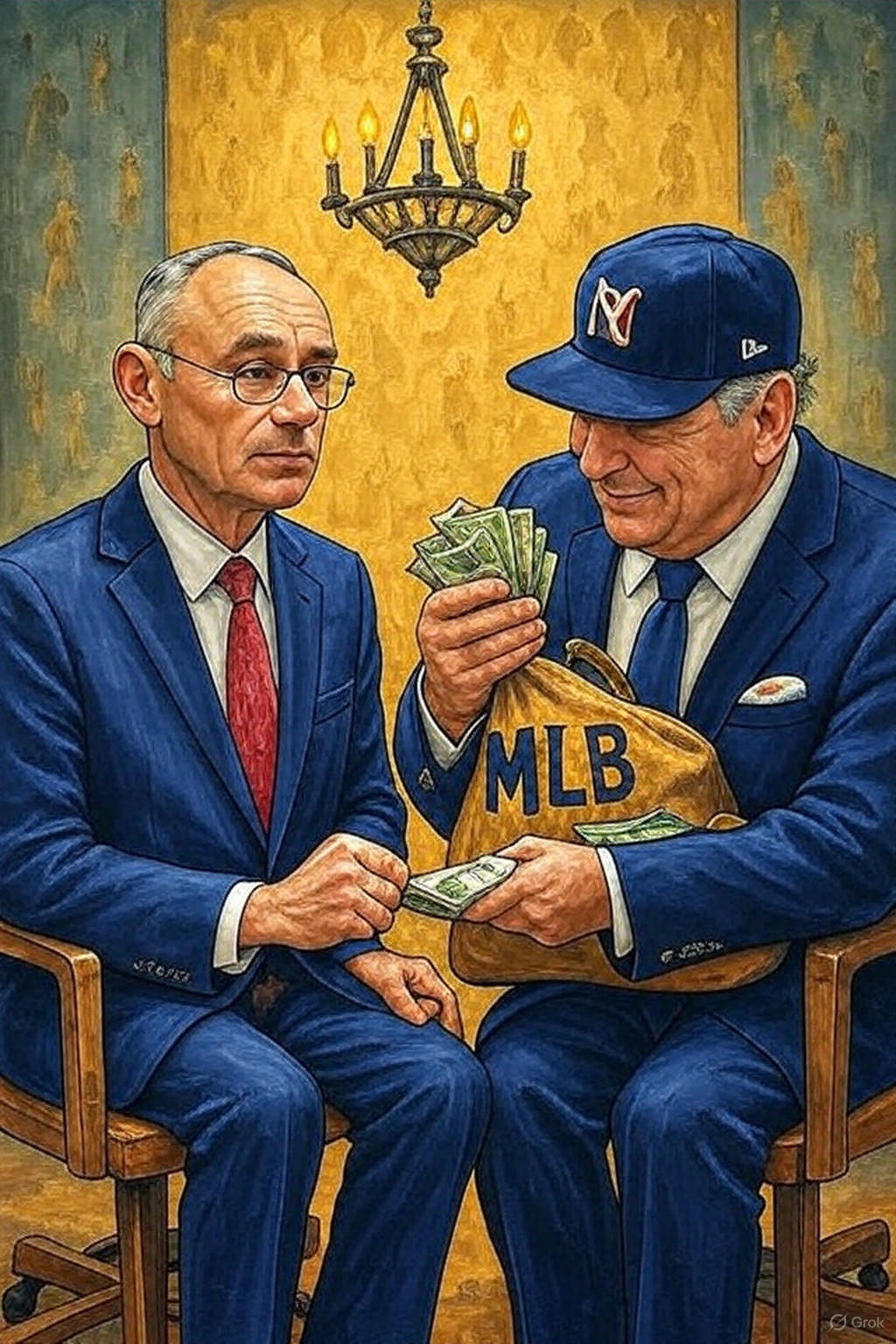65 MLB Financial Statistics for 2025

A new report by Doc’s Sports explores Major League Baseball’s financial landscape—from league revenue and franchise valuations to payroll trends, media rights, and long-term growth. MLB now generates more than $12 billion annually, reaffirming its position as one of the highest-grossing professional sports leagues in the world.
How Much Revenue Did MLB Generate in 2024?
Figures reflect official reporting, financial disclosures, and industry estimates to provide the most accurate picture of MLB’s total economic output.
- The MLB generated $12.1 billion in total revenue during 2024, setting a new all-time record for the league.
- The average MLB team earned about $386 million in 2023, though the gap between large and small markets remains wide.
- MLB’s $12 billion economy now exceeds the GDP of more than 50 countries, underscoring how global the business of baseball has become.
- League revenue has grown 264 percent since 2000, fueled by media deals, licensing, and stadium investments.
- The MLB welcomed 70.75 million fans in 2023, the first time attendance topped 70 million since 2018.
- From 2020 to 2024, total revenue jumped 70 percent, highlighting baseball’s rebound from the pandemic.
- About 85 percent of MLB revenue is local—from ticket sales, concessions, and regional TV—while only 15 percent comes from national sources.
- The league’s overall growth rate since 1970 averages around 11 percent per year.
What Is the Average MLB Franchise Valuation in 2025?
Team valuations have soared as investors see sports ownership as both a business and a legacy asset.
- The average MLB franchise is valued at $2.62 billion (CNBC), a seven percent increase over the past year.
- The New York Yankees remain the most valuable team in baseball at $8.20 billion.
- The Los Angeles Dodgers are second at $6.8 billion (Forbes), powered by their massive media market.
- The Red Sox, Cubs, and Giants each top $4 billion in valuation, rounding out the top five.
- Even the Miami Marlins, MLB’s smallest-market team, are valued around $1.3 billion.
- Combined, MLB’s 30 teams are worth roughly $82–85 billion, reflecting the sport’s deep financial strength.
- Franchise values have risen 2,500 percent since 1990, easily outpacing inflation and the broader stock market.
- The Yankees’ value has increased more than 20-fold since the early 2000s, from under $400 million to over $8 billion.
- On average, MLB teams appreciate about 10 percent per year, consistent with decades-long investment returns.
- The typical franchise trades at 8–12 times annual revenue, a valuation ratio comparable to the NBA’s.
MLB Payrolls and Player Salary in 2025?
Player pay continues to climb, yet spending power is concentrated among big-market teams and superstar contracts.
- MLB operates without a hard salary cap but enforces a Competitive Balance Tax (CBT) to discourage excessive payrolls.
- The 2025 CBT threshold is $241 million, the highest in league history.
- The threshold has increased steadily—from $230 million in 2022 to $241 million in 2025—mirroring revenue growth.
- The average player salary reached $5.16 million in 2025, surpassing $5 million for the first time.
- The median player salary fell slightly to $1.35 million, reflecting more rookie and pre-arbitration players on rosters.
- The minimum salary rose to $760,000, meaning even the youngest big leaguers earn three-quarters of a million dollars.
- Players’ share of revenue has settled around 47 percent, compared with over 50 percent two decades ago.
- The New York Mets’ $355 million payroll in 2023 remains the largest in MLB history.
- The Dodgers ($319.5 Millon) and Yankees ($272 Millon) lead 2025 payrolls, while the Marlins ($64.9 Million) sit at the bottom.
- A record nine teams exceeded the CBT limit in 2024, underscoring the gap between high-spenders and everyone else.
- Shohei Ohtani leads all players with $102.5 million total earnings ($2.5 million salary + $100 million endorsements)
- More than 15 players earn $30 million or more annually, while 38 make over $20 million.
- Over half of all active players earn under $1 million, revealing a growing pay divide between stars and role players.
- Clubs contribute more than $300 million a year to benefits and pension plans in addition to base salaries.
- The first luxury-tax line in 1997 was just $51 million—less than one ace pitcher’s salary today.
- The average player salary has increased 100× since 1975, when it was $45,000.
- The league minimum has climbed 4,650 percent, from $16,000 in 1975 to $760,000 today.
- MLB payroll efficiency averages about 2.3:1, meaning every dollar spent on salaries produces roughly $2.30 in revenue.
How Has MLB Revenue Grown Over Time?
Baseball’s transformation from a regional pastime to a global entertainment business is one of sports’ great economic success stories.
- MLB revenue has increased from $200 million in the 1970s to over $12 billion today, a 5,700 percent surge.
- Between 2019 and 2023, MLB revenue grew 8.4 percent overall and nearly 30 percent since 2021.
- The 2024 season marked MLB’s second consecutive record year, continuing its steady climb.
- The average MLB team now earns $20–25 million in annual profit, depending on market size and stadium debt.
- The Seattle Mariners led MLB in 2024 with an estimated $86 million in operating profit
- Most teams operate on single-digit margins, using stadium revenue and appreciation as their real profit engines.
- Since 2000, MLB franchise values have outperformed the S&P 500 by nearly threefold
- Nolan Ryan became MLB’s first $1 million-a-year player in 1980; now more than 570 players earn at least that much.
- Average team valuations have climbed around 10 percent annually since the 1990s.
- The San Francisco Giants, purchased for $100 million in 1993, are now valued near $4 billion—a 40× return on investment.
MLB’s Media Rights Value in 2025?
National and streaming contracts remain MLB’s financial backbone, combining long-term stability with new digital growth.
- MLB’s national broadcast partners generate about $1.75 billion annually, forming the league’s central income stream.
- FOX Sports pays $729 million per year for national and postseason coverage.
- Turner Sports (TBS) adds roughly $470 million per year for Sunday and playoff broadcasts.
- ESPN opted out of its MLB contract in February 2025, ending the relationship after 2025 season
- Apple TV+ pays $85 million per year for its Friday Night Baseball package.
- NBC Sports is finalizing a $200 million-per-year agreement to join future MLB coverage, expanding national exposure.
- Together, these deals produce nearly $2 billion a year in media revenue, a figure expected to climb after 2028.
- Each club receives roughly $60 million annually from MLB’s central media fund.
- Regional Sports Networks remain in flux due to cord-cutting and the Diamond Sports Group bankruptcy, which is reshaping local TV.
What Portion of MLB Income Comes from International Markets?
Global expansion is now a key growth driver, with new fans and new markets fueling revenue outside North America.
- International markets contribute 10–15 percent of total league revenue, primarily through broadcasting and merchandise.
- MLB hosted regular-season games in London, Seoul, and Mexico City in 2024,
- MLB broadcasts now reach more than 200 countries
- Europe and Latin America are MLB’s fastest-growing regions, showing about 15 percent annual engagement growth.
- The MLB aims to push international income to 20 percent of total revenue by 2030, driven by overseas series and streaming partnerships.
How Much Revenue Does MLB Generate Per Player?
League-wide totals divided by active roster size offer a glimpse at baseball’s sheer economic scale.
- MLB produces roughly $26.9 million in revenue per active player, based on league totals and a 450-player roster.
- Each regular-season game generates about $4.6 million in revenue, averaged across 2,430 games.
- Baseball’s compound annual growth rate since 1970 is around 11 percent, consistent with steady expansion across eras.
- MLB teams maintain a value-to-revenue multiple of 8–12×, reflecting strong investor confidence.
- The revenue yield on franchise values averages about 8 percent, signaling healthy long-term returns for owners.
Methodology / Sources
All financial figures represent nominal U.S. values from industry-verified databases and reports. Where official numbers are not published, Doc’s Sports used reasonable estimates based on aggregate league data and public ratios
- Forbes – MLB Revenues Hit Record $12.1 Billion in 2024 (Maury Brown, Jan 2025)
- Associated Press – 2025 Opening Day Salary Survey
- Sportico – MLB Team Valuations 2025
- Forbes – Business of Baseball 2025 Valuations
- MLB.com – Collective Bargaining Agreement (2022–26)
- ESPN – Record 9 Teams to Pay Luxury Tax in 2024
- CNBC’s Official MLB Team Valuations 2025: Here’s how the 30 franchises stack up
Get MLB picks on every single game, or if you want our very best bets by the experts, sign up for your free $60 account with a guarantee.
Most Recent Baseball Handicapping
- 6 MLB Coaches Who Were Better Players Than Skippers
- 65 MLB Financial Statistics for 2025
- Five MLB Players Who Went from MVP Talks to Out of the League
- MLB Prospects Who Were Hyped as the Next Big Thing and Flopped
- Best Bets for Teams to Make the MLB Playoffs: Yes or No Props
- 5 Underperforming MLB Pitchers who Dominated in the Postseason
- Six MLB One Season Wonders Who Fell Off Fast
- Top 6 Forgotten MLB Postseason Clutch Performances
- MLB Season Awards with Updated Odds and Predictions
- Chicago Cubs vs Houston Astros Weekend Series Predictions with Odds and Analysis
